Sedimentation is a common water treatment method used in drinking water and wastewater treatment plants.
The process causes suspended solids to sink to the bottom of the sedimentation tank, where they can be easily removed from the water. Sedimentation is usually followed by subsequent water treatments.
📌 Key Takeaways:
- Sedimentation water treatment is the process of removing suspended particles from water by encouraging them to settle at the bottom of the tank, where they can be removed periodically.
- The sedimentation process usually follows on from coagulation and flocculation, and is preceded by filtration and disinfection.
- Water treatment plants use sedimentation to reduce the chemicals – and their associated costs – requires at later treatment stages.
Table of Contents
- 🔎 What Is Sedimentation? Quick Overview
- 🤔 How Does The Sedimentation Process Work?
- ⚗️ Sedimentation In Wastewater Treatment
- 🧪 Chemicals Used To Aid Sedimentation
- 🚰 Tanks And Clarifiers Used To Streamline Sedimentation
- ⚖️ Pros & Cons of Sedimentation In Water Treatment
- 📑 Final Word
- ❔ Sedimentation In Water Treatment: FAQ
🔎 What Is Sedimentation? Quick Overview
Just looking for a quick overview of sedimentation water treatment?
Sedimentation is the process of separating suspended solids from a liquid using gravity.
Coagulants and flocculants are added to the water to encourage the particles to sink and settle, becoming sediment, or sludge. The water above the sludge can continue to the next treatment stage, and the sludge is removed periodically with the use of a sludge pump.
Sedimentation is commonly used in drinking water treatment and wastewater treatment plants, and is otherwise called settling.
The process is usually preceded by further water treatment stages, including filtration with fine sand or gravel filters, and water disinfection.
👨🔧 Check out our water treatment guide to learn more about the processes involved in treating drinking water or wastewater.
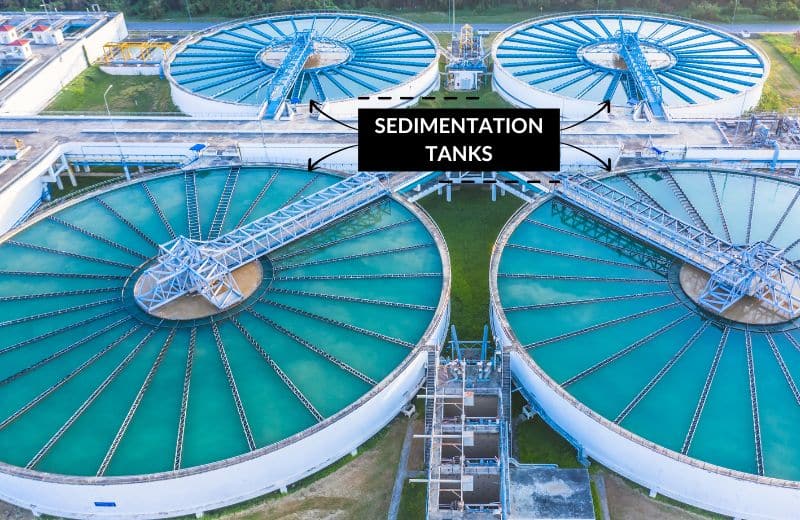
🤔 How Does The Sedimentation Process Work?
The sedimentation process works by separating solids from a liquid, usually with the use of coagulants and flocculants, which encourage particles to sink and settle at the bottom of the sedimentation tank.
To understand how sedimentation works, we need to understand the sedimentation theory. Essentially, this theory says that any object with a density greater than a liquid will sink when added to the liquid.
The size, density, and physical properties of the solids in the water affect the sedimentation processes that may be used.
The four common sedimentation processes are:
Free Settling
Free settling, or discrete settling, is used to promote the sinking and settling of particles that have a low suspended solids concentration. Free settling enables particles to settle separately, without interacting significantly with other solids.
Flocculent Settling
Certain types of particles flocculate (form small clumps or masses) while they’re settling. Flocculation is a helpful precursor to sedimentation because it increases the mass of individual particles by joining them together, causing them to settle at a faster rate.
Hindered Settling
Particles with a higher suspended solids concentration are closer together in water, meaning that they have increased interaction with other particles, which affects their settling. During hindered settling sedimentation, particles settle as a zone or a mass.
Compression Settling
Finally, compression settling, or floc blanket sedimentation, refers to the process of sedimentation in water with such a high suspended solids density that the solid particles are constantly touching one another. In this scenario, the particles settle as one, in a “sludge blanket”, with the weight of the upper layers being supported by the lower layers. The force of the sludge blanket squeezes out the water trapped between the particles.
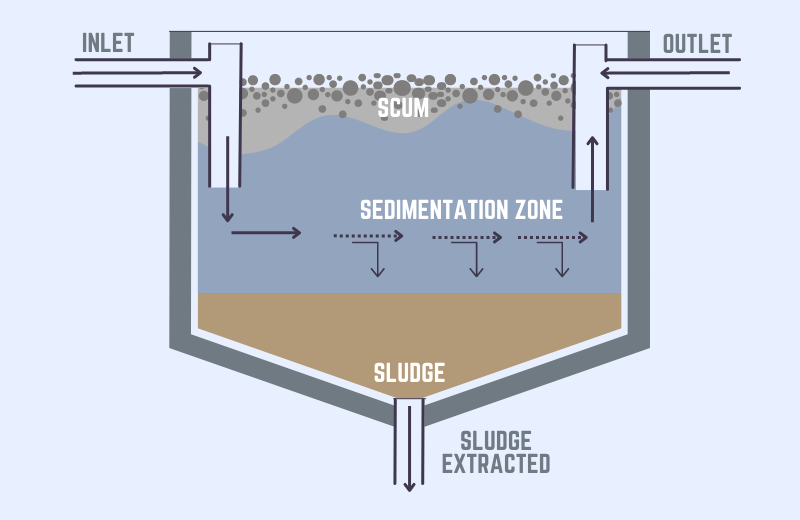
⚗️ Sedimentation In Wastewater Treatment
Sedimentation is a particularly important step in wastewater treatment, when there are lots of solids to separate from the water.
Sewage treatment plants have numerous sedimentation tanks (otherwise called plain sedimentation tanks, primary settling tanks, or sedimentation basins) where sewage is left to sit idly, allowing the process of sedimentation to occur naturally and gradually.
These plants may also have secondary sedimentation tanks, which are used to further settle effluents after secondary treatment steps.
🧪 Chemicals Used To Aid Sedimentation
There are two types of chemicals that are commonly used to aid sedimentation: coagulants and flocculants.
Coagulants
Most of the colloids and suspended particles in untreated water are negatively charged, which causes them to repel one another (push each other away). This prevents the particles from settling since they’re more likely to stay suspended in the water.
Using a chemical coagulant in the water, such as aluminum sulfate, ferric sulfate, or sodium aluminate, neutralizes the charge of these particles, which encourages them to bind together and form micro-flocs.
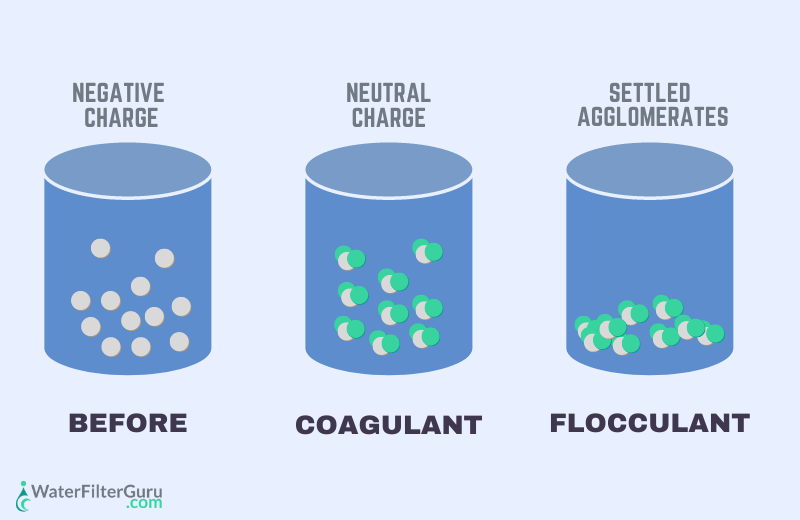
Flocculants
At this point, the micro-flocs still aren’t dense enough to settle naturally at the bottom of sedimentation tanks, so flocculants are added to increase the sizes of the suspended particles and promote further clumping. This increases the rate of settling and sedimentation.
Coagulants and flocculants are important precursors to sedimentation. In most scenarios, sedimentation couldn’t occur effectively without the use of coagulants and flocculants.
🚰 Tanks And Clarifiers Used To Streamline Sedimentation
The process of sedimentation is streamlined through the use of tanks and clarifiers. These make it easy to store, manage, and remove the sludge formed when suspended particles settle in a layer beneath the water.
Some of the most common tanks and clarifiers used in sedimentation water treatment are:
Radial Flow Tanks
Radial flow tanks have a circular design with a cone-shaped base, which is used to evacuate sludge. These tanks use rakes that rotate, compacting sludge and moving it into the center of the base, where it can be removed.
Raw water is introduced into the tank at its periphery or through a feed-well at the tank’s center. Center feed-wells are preferable because they allow water to be evenly distributed and provide the energy needed to mix the coagulants and flocculants, allowing for the most efficient process.
Horizontal Flow Tanks
Horizontal flow tanks provide the most simple form of sedimentation. Raw water is sent into one end of the tank and flows through to the other side. The water’s solids gradually form a sludge layer at the bottom of the tank. Once the water reaches the other end of the tank, most of the suspended particles should have settled.
A horizontal flow tank usually has a sloping base, which helps to promote the buildup of sludge. The accumulated solids at the bottom of the slope can be discharged in a sludge pump.
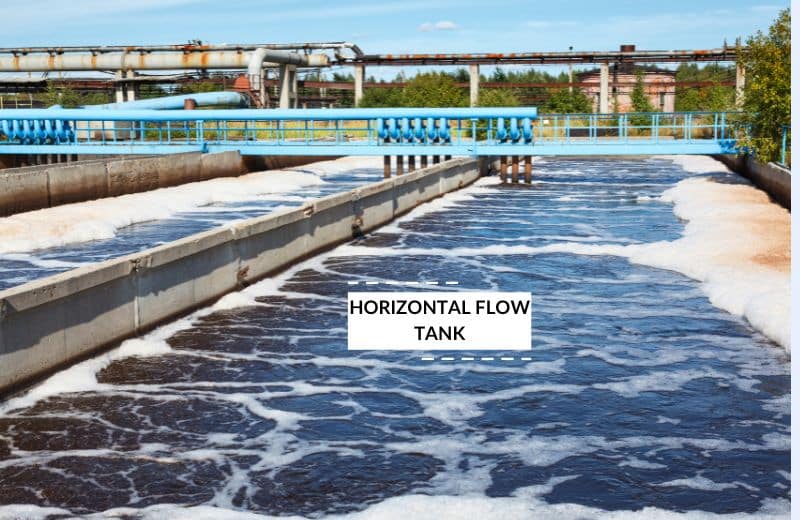
Ballasted Sedimentation
Ballasted sedimentation is the process of combining flocculation and coagulation with a recycled media (or ballast) to trap the flocs. Using a media (which is usually made from sand) promotes faster settling than an operation with no media.
The ballasted sedimentation process works as follows:
- Raw water is fed into a tank, where a coagulant is mixed in.
- Once coagulated, the water travels into a second tank for flocculation. Here, a flocculant polymer and micro-sand are added to the water, and the suspended particles are encouraged to form large flocks.
- Next, water flows into a clarification tank, where the particles settle (usually on inclined plate or tube settlers, which speeds up the settling rate).
- The settled solids are sent into a hydrocyclone, where they’re separated from the micro-sand, enabling the micro-sand to be reused.
Inclined Plate Or Tube Settlers
Many tanks and clarifiers use inclined tube and plate settlers to increase the surface area for settling, aiding sedimentation.
This setup sees a series of tubes or plates installed inside the tank at a 60-degree angle to the surface. Water entering the system flows up between the tubes or plates, and the sludge collects along their surfaces.
The tubes and plates enable a process called slipstreaming, or drafting, which allows particles to group up on their surfaces and draft off one another, causing them to settle at the bottom of the sedimentation tank at a faster rate.
High Compaction Clarifying Thickener
A relatively modern invention for sedimentation is the high compaction clarifying thickener. This combines the benefits of a clarifier (the production of clean water that can be reused) with the advantages of a thickener (sludge that’s easier to manage).
A high compaction clarifying thickener has a vertical tank design with a cone-shaped bottom and rotating rakes. These rakes compact the flocs, causing them to form a thick sludge, which is then further compacted when it is forced into the cone-shaped tank base.
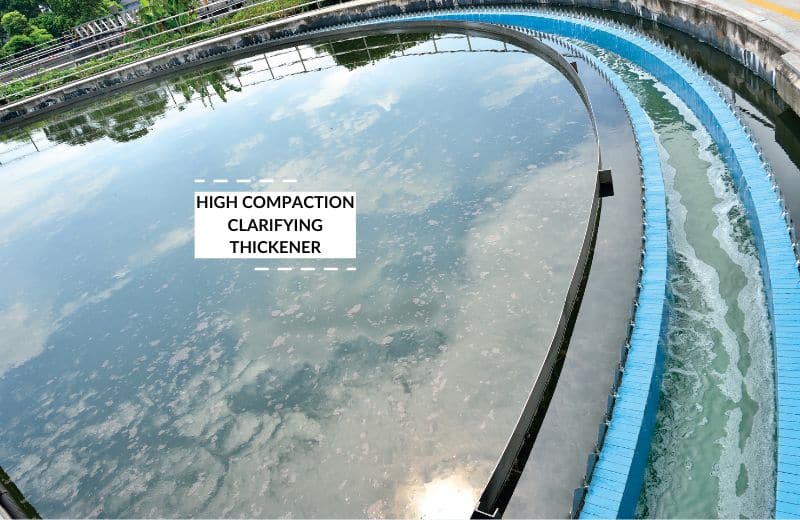
Settling Ponds
Finally, settling ponds (or settling lagoons or basins) are an old and widely-used sedimentation solution. Settling ponds allow for a gradual reduction of particle concentration, giving plenty of time for suspended solids to settle naturally.
This settled sludge is usually removed from the settling pond with a front loader or an excavator.
There are a variety of designs and sizes available for settling basins. The idea is that solids collect at the base of the pond as water flows into the next treatment stage.
While settling ponds are an affordable option, they’re not often efficient due to the slow speed of natural particle settling.
⚖️ Pros & Cons of Sedimentation In Water Treatment
Now we know how the process of sedimentation works, what are its advantages and disadvantages in drinking water and wastewater treatment?
Pros:
- Simple & cheap to install. Compared to other stages of water treatment, installing rectangular tanks for sedimentation is relatively cheap and easy.
- Simplifies subsequent processes. Removing suspended particles in a settling tank improves water quality significantly, which makes the subsequent treatment processes easier.
- Reduces chemical use. Because of this improved water quality, fewer chemicals are needed to further treat the water.
- Cheaper than other methods. The cost of sedimentation is typically lower than some of the alternative treatment methods.
Cons:
- Slow process. The sedimentation process relies on gravity, so it takes a long time, especially in scenarios where there are a lot of solids. Increasing particle density and allowing all particles to settle in sedimentation tanks takes 3-4 hours on average.
- Takes up a lot of space. A settling tank or sedimentation basin takes up a lot of room, so it’s not an ideal solution in applications where space is limited.
- Limited modification options. Once the rectangular tanks for sedimentation are set up, there’s little opportunity for the operator to make modifications – the design is always intended for the maximum volume.
📑 Final Word
In most scenarios, sedimentation is an essential stage of water treatment. The procedure is affordable and easy to set up, and helps to simplify the further treatment processes required, even if the settling process is time-consuming.
Both drinking water treatment and wastewater treatment plants use sedimentation to separate suspended particles from water, significantly improving water quality and clarity and minimizing chemical use in later stages of treatment.
❔ Sedimentation In Water Treatment: FAQ
What is sedimentation in water treatment process?
In water treatment, sedimentation follows coagulation and flocculation, and is used to remove accumulated solids from water. The process takes place in a sedimentation tank. The accumulated solids settle at the bottom of the tank as a sludge, while the water continues on to the next treatment stage. This sludge is then removed periodically.
What is the purpose of sedimentation?
The purpose of sedimentation is to provide an easy way to reduce particle concentration in water, which improves water clarity and quality. Sedimentation also enhances the water treatment process (both for drinking water and wastewater) and reduces the filtration steps that must be taken afterward.
Which chemical is used in sedimentation of water?
There are several chemicals that may be used to aid in the sedimentation process, including polyaluminum chloride, aluminum sulfate, and ferric sulfate. There are other coagulants and flocculants which may also be used to aid in the process, depending on the treatment setup.
Is sedimentation a good thing?
In the context of water treatment, yes, sedimentation is a good thing. It allows for an easy method of removing solids from water, which would otherwise require extensive treatment and filtration processes. Sedimentation reduces the chemicals required for subsequent water treatment and is lower in cost than similar water treatment methods.
